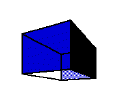 |
 |
 |
Have you ever wanted to draw a realistic picture of a solid (three-dimensional) object on a flat (two-dimensional) piece of paper? In this lesson we will study two ways of making such drawings.
To make drawings of three-dimensional objects as "realistic" as possible, we must try to convey the impression that parallel lines get closer and closer together as they get farther and farther from the observer.
Task 1. Study the three pictures of cubes below. Some edges which we know are parallel do not appear to be parallel in these pictures. Discuss with your partner which edges do not look parallel even though they "really" are. Then write a short answer on your lab sheet that explains, in your own words, how each of the three pictures represents parallel lines.
(Note: in each figure, there is a dark blue side, a lighter blue side opposite the dark blue side, a black side, and three transparent sides. In each figure, the dark blue side is toward the front. The top, the bottom, and one other side are transparent.)
 |
 |
 |
One way to "realistically" picture three dimensional objects in two dimensions is to use horizon lines and vanishing points.
A horizon line is a line (usually horizontal) at the observer's eye level.
A vanishing point is a point where parallel lines appear to meet on the horizon line.
Task 2. The following Sketchpad document will give you an opportunity to explore what happens when you move an object relative to the horizon line. Follow the directions that are included in the Sketchpad document. When you have finished experimenting, and you have discussed this task with your partner, write a short answer on your lab sheet that explains, in your own words, how the observer, the object, and the observer's "line of sight" are related.
When converging parallel lines appear to meet at a single vanishing point, we say that the figure has one-point perspective. The object that you were manipulating in the Sketchpad document had one-point perspective.
A first Sketchpad document shows how a cube with one-point perspective can be constructed. See if you can understand how the one-point perspective cube was constructed. Refer also to page 130 in our textbook, Addison-Wesley Secondary Math, An Integrated Approach: Focus on Geometry for directions for drawing a cube in one-point perspective.
A second Sketchpad document shows the same cube with everything hidden except "lines" to the vanishing point. Follow the directions that are contained in the Sketchpad document and try to understand the relationship between these lines and the edges of the cube.
When there are two vanishing points, we say that an object has two-point perspective. In a figure with two-point perspective, converging parallel lines do not all meet at a single point. Some meet at one vanishing point, and the rest meet at the other vanishing point.
Task 3. The following Sketchpad document pictures two cubes, one with one-point perspective, and one with two-point perspective. Follow the directions that are included in the Sketchpad document. When you have finished experimenting, and you have discussed this task with your partner, write a short answer on your lab sheet answering one of the two questions in the Sketchpad document.
A first Sketchpad document shows how a cube with two-point perspective can be constructed. See if you can understand how the two-point perspective cube was constructed. Refer also to page 131 in our textbook, Addison-Wesley Secondary Math, An Integrated Approach: Focus on Geometry for directions for drawing a cube in two-point perspective.
A second Sketchpad document will show the same cube with everything hidden except "lines" to the vanishing points. Follow the directions that are contained in the Sketchpad document and try to understand the relationship between the lines to the vanishing points and the edges of the cube.
Task 4. Choose one of the four tasks listed below. If you choose one of the computer options, save the Sketchpad file to your disk when you have finished, print a copy to turn in, and invite me see your computer to admire yout work.
Option 1: draw a picture with one-point perspective using paper and pencil.
Option 2: complete a Sketchpad sketch with one-point perspective.
Option 3: draw a picture with two-point perspective using paper and pencil.
Option 4: complete a Sketchpad sketch with two-point perspective.